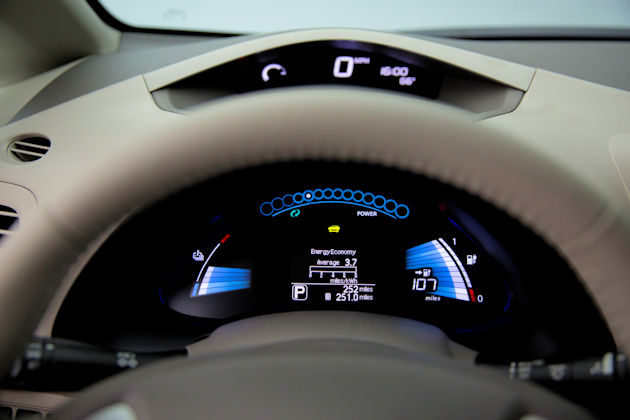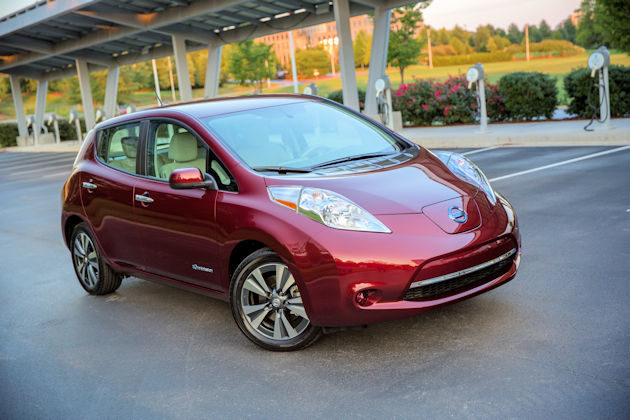
By Barbara & Bill Schaffer
Buying a Nissan Leaf is something like buying a refrigerator. You plug the refrigerator in and it is great for preserving foods, keeping drinks cool and keeping your ice cream freezing until it?s time to indulge. The Nissan Leaf works the same way, you plug it in an it gives you great transportation like commuting, running errands and taking the kids to soccer practice. Think of it as a transportation appliance.
As the world?s first affordably priced electric car when it debuted in 2010, the 2016 Nissan Leaf still does the best job of providing drivers with the basic electric car experience and dependability. It has worked so well, that there are currently 185,000 current leaf owners around the world.

The Nissan Leaf is available in three trim levels the S, SV and SL which are priced at $29,860; $35,050 and $37,640 respectively, including the destination charge. For someone looking for a nicely equipped simple electric car the model S is the equivalent of that basic refrigerator, and when the tax credits are considered it becomes an outstanding transportation value.

The 2016 S model, which still has a range of 84 miles, did get enhanced audio, entertainment and connectivity features including NissanConnect with Mobile Apps and a 5.0-inch color display screen as a standard feature on the base S model, too. This allows the driver/passenger to connect your phone through the Bluetooth? system, play streaming audio, use Hands-free Text Messaging Assistant and use the USB connection port for compatible digital devices.

For shoppers who want a little more in their car, the SV and SL are like some of those fancier three- or four-door refrigerators. While the Nissan Leaf didn?t get the fancy video screen in the door, like the new Samsung refrigerator they did get many enhancements for 2016, the most significant being a larger battery which increases the driving range to an estimated 107 miles.

Andrew Speaker, director, Nissan EV Sales & Marketing, Nissan North America, Inc. explains the new battery this way, ?The new battery offers more advantages than just the 27 percent increase in driving range ? it also offers improved battery performance,? he said, ?Nissan has been a leading developer of lithium-ion battery technology for more than 20 years. The new LEAF battery is a great example of how rather than just increasing battery capacity, we?ve achieved a balance between capacity, packaging, durability and affordability.?

Connectivity is one of the most important features younger new car shoppers look for, so Nissan made improvements to Leaf including making NissanConnect with Navigation, Mobile Apps and EV standard on the upper level models. This includes a seven-inch color display with multi-touch control, Nissan Voice Recognition for navigation and audio, HD radio, and SiriusXM Travel Link? for weather, fuel prices, movie listings, stock info and sports.

The NissanConnect EV telematics system allows the owner to remotely connect to the Leaf to start the charging, monitor the charge, or even to turn on the heating and air conditioning system before the driver gets to the car.

The Nissan Leaf SV has a high-response 80kW AC synchronous motor which is rated at 107-hp and 187-lb.ft. of torque. It drives the front wheels through a single-speed reducer so that there is no transmission other than for forward and reverse. With the new 30 kWh battery, (earlier models and the S model use a 24 kWh battery) the Leaf gets an EPA rating of 124 MPGe (miles per gallon equivalent) for city driving, 101 MPGe highway and 112 MPGe combined. The smaller battery is rated at 126 city, 101 highway and 114 combined. But the important number for owners is the range which is estimated to be 107 miles now, up from the previous 84-mile range.
That range is about twice what an average driver drives daily, so it would be perfect for a driver who commutes to work, less than 50 miles each way, unless a charger is available at work. For drivers who live in states that have HOV lanes, Leaf drivers can get permits to access the lanes without having passengers.

Plugging into a 110-volt outlet home charger will require up to 21 hours for a full charge, but a 240-volt charger only takes about six hours. A quick charge port, which is standard on the SV and SL, allows the car to be charged at quick charge facilities, to about 80 percent capacity, in about 30 minutes.
We enjoyed driving the Leaf because it?s so quiet, responsive and user-friendly. Some electric-powered cars have extremely strong acceleration, but the Leaf is designed for efficiency and a more average driving style. According to buff magazine testing, the Leaf makes a 0 to 60 mph acceleration run in 10.4 seconds, making it a bit slower than most high fuel economy gasoline powered cars. Out on the road, the Leaf will make reasonably passes quickly, but we?d avoid those marginal passes. The Leaf SL has a photovoltaic solar panel on the spoiler that helps charge the 12-volt battery that powers vehicle accessories. The Leaf also supplements the drive battery charging with a regenerative braking system that adds to the charge when the car is braking or coasting. The driver can choose from two settings with the ?Bmode? setting producing a more aggressive regenerative braking level.

Because the car is so silent, pedestrians will often not hear the Leaf, so Nissan has designed an ?Approaching Vehicle Sound for Pedestrians? system which emits a sound from a speaker in the front of the vehicle. The sound turns off when the vehicle reaches 19 mph.
With its low center of gravity, the Nissan Leaf handles well, has a light agile feel, and it holds to corners tightly. The reaction to accelerator and braking is smooth and the car produces a solid comfortable ride even over rough roads.
We?re not crazy about the Leaf?s unique exterior styling especially the headlights, but it wasn?t designed to win beauty contests, it was designed to cheat the air flow, which it does with a low 0.28 coefficient of drag.

It?s comfortable, efficient and pleasant to drive. The interior is roomy enough to carry five adults and still has 23.6 cubic feet of cargo space, or 30 cubic feet with the second row folded.

For someone who commutes, runs errands and makes lots of short trips near home, we think the Leaf is the perfect car. But for road trips or long weekends you?ll need a second vehicle or need to rent one, which isn?t a bad option.







